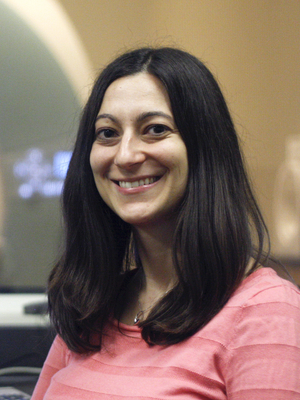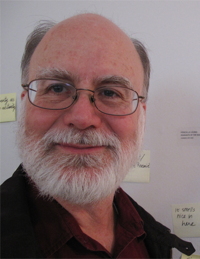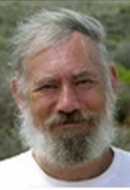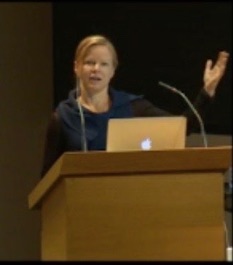PPVS2019: Titles and Abstracts
These are the titles and abstracts of the talks at the Interdisciplinary Workshop on the Philosophy and Psychology Visual Space (PPVS2019) on 15 and 16 February 2019.
The detailed Conference Program is available from the Conference Brochure and also the workshop's main page. Video recordings of most of the talks are available on OnNeuro and are posted on their YouTube channel. Special thanks to Paul Scotti for making the recordings and posting them on-line.
- Julie Golomb: Representations of 2D and 3D spatial location in the brain
- Carl Granrud: Development of Visual Size Constancy in Children: Testing Three Theories
- E. J. Green: Spatial Functionalism, Vision Science, and the Prospects for Anti-Skepticism
- Gary Hatfield: Phenomenally Converging Railway Tracks: A Misperception?
- Jan Koenderink: Visual Spaces and Less
- Farid Masrour: The Geometry of the Visual Field and its Philosophical Significance
- Alexander Petrov, Declan Smithies, & Ying Yu: A New Puzzle about the Visual Appearance of Space
- Susanna Schellenberg: Constancy, Variance, and Situation-Dependent Properties
- James Todd: Is there a consistent geometry of visual space? And, why should judgments of 3D structure be systematically distorted?
- Mark Wagner: Putting the Geometries of Visual Space into Perspective
All sessions were in Room 035 of the Psychology Building on the Columbus campus of the Ohio State University.
Julie Golomb
Representations of 2D and 3D Spatial Location in the Brain
Speaker: Julie Golomb
Affiliation: Ohio State University, Psychology
Schedule: 1:30 - 2:45 pm on Friday (2/15)
Session chair: Vladimir Sloutsky (Ohio State University, Psychology)
OnNeuro video: http://www.youtube.com/watch?v=k4RJKPt6RTg
Abstract:
How is visual space represented in the brain? It is well-known that much of visual cortex is topographically organized, with neighboring neurons in the retina representing neighboring locations in space, and these retinotopic "maps" preserved in the primary visual areas of the brain. But an image's simple location on the retina is not always the most relevant for human behavior, especially given that: (1) retinotopic maps are 2D representations, but we live in a 3D world, and (2) the eyes are constantly moving, creating a discrepancy between eye-centered and world-centered spatial reference frames. Thus, for successful perception and action in the real world, the visual system needs to transform the initial 2D, retinotopic information into more behaviorally relevant spatial coordinates. I will present some recent work from my lab using fMRI to explore what types of spatial information are represented throughout human visual cortex. I will focus in particular on a sequence of studies using different computational analysis techniques to investigate the transformation from 2D to 3D spatial information in the brain, including preliminary evidence for the existence of a map-like representation of position-in-depth. My talk will also touch on broader questions about the existence of spatial maps in the brain and what sort of insights we can gain into our understanding of visual space from human fMRI.
See photos of the talk or
go back to the Workshop main page.
Carl Granrud
Development of Visual Size Constancy in Children: Testing Three Theories
Speaker: Carl Granrud
Affiliation: University of Northern Colorado, Psychology
Schedule: 3:00 - 4:15 pm on Friday (2/15)
Session chair: David Hilbert (University of Illinois at Chicago, Philosophy)
Abstract:
The ability to estimate a distant object's size improves during childhood. Three theories attempt to explain this developmental change. We refer to these as the perceptual learning, proximal mode sensitivity, and metacognitive theories of size constancy development.
According to the perceptual learning theory, age-related increases in far-distance size perception accuracy result from a developmental increase in sensitivity to visual cues for size and distance. Our research conflicts with this theory. In several studies, we have found no difference between children and adults in sensitivity to visual cues for size and no correlation between sensitivity to visual cues and accuracy of far-distance size estimations.
According to the proximal mode sensitivity theory, children are more responsive than adults to proximal mode features, such as retinal size, and this greater proximal-mode responsiveness causes underconstant size estimates. Our research conflicts with this theory as well. In one study, children made less accurate far-distance size estimates than adults when estimates could not be based on proximal mode features, contrary to this theory's predictions.
According to the metacognitive theory, improvements in far-distance size estimation accuracy result from age-related increases in reasoning ability, metacognitive awareness, and the use of deliberate size-estimation strategies. Our research strongly supports this theory. Several studies have found that age-related increases in reasoning ability and strategy use account for the age-related increases in far-distance size estimation ability that we have observed.
Back to the Workshop main page.
E. J. Green
Spatial Functionalism, Vision Science, and the Prospects for Anti-Skepticism
Speaker: E. J. Green
Affiliation: Massachusetts Institute of Technology, Philosophy
Schedule: 1:30 - 2:45 pm on Saturday (2/16)
Session chair: Robert Briscoe (Ohio University, Philosophy)
Abstract:
Spatial functionalism is the view that spatial concepts, as well as spatial experiences, represent whatever worldly entities play a certain functional role. I use both a priori and empirical considerations to argue against the most prominent form of spatial functionalism: causal phenomenal spatial functionalism, on which spatial concepts refer to whatever properties normally cause certain spatial experiences (Chalmers forthcoming; Searle 2015). I examine the prospects for other versions of spatial functionalism and their ability to deliver the result that allegedly skeptical scenarios like the Matrix and brain-in-vats are not, in the end, skeptical scenarios after all. Although causal phenomenal spatial functionalism is false, I suggest that there is room for other versions of spatial functionalism that both comport with contemporary vision science and deliver the surprising anti-skeptical conclusion that inhabitants of certain Matrix scenarios are in fact less deceived than their real-world counterparts, i.e. us. (This talk is based on collaborative work with Gabriel Rabin, NYU Abu Dhabi.)
See photos of the talk or
go back to the Workshop main page.
Gary Hatfield
Phenomenally Converging Railway Tracks: A Misperception?
Speaker: Gary Hatfield
Affiliation: University of Pennsylvania, Philosophy
Schedule: 4:30 - 5:45 pm on Friday (2/15)
Session chair: Lisa Shabel (Ohio State University, Philosophy)
OnNeuro video: http://www.youtube.com/watch?v=MghTwRCijLo
Abstract:
Railway tracks appear to converge into the distance. Is this appearance a misperception?
Typically, observers don't believe that they do converge physically. These statements thus far are consistent with treating the apparent convergence as a case of illusion, like the Mueller-Lyer illusion. One line looks longer than the other, an appearance widely considered to be illusory, yet we are not taken in and so we don't misperceive in the sense of making a false judgment about the actual length of the lines -- or about the actual physical width between the tracks. Here, one might say that there is phenomenal misperception of line length but no judgmental misperception. Good enough.
But I intend to pursue the idea that the converging train tracks are not a misperception in this phenomenal sense. Construing them as a misperception depends, in my estimation, on a particular task analysis of phenomenal perception: that it aims to present physical scenes in a way that conforms to their mind-independent physical structure. This is a widely held conception, infused even into Gibson's ecological approach. My idea is that the contraction of visual space, as with the tracks, is not a mistake brought about by inadequate information about distance, but rather a phenomenal accommodation of the decreasing information with distance, an accommodation that presents the tracks in a manner which reveals action-guiding information and is ecologically efficient.
See photos of the talk or
go back to the Workshop main page.
Jan Koenderink
Visual Spaces and Less
Speaker: Jan Koenderink
Affiliation: KU Leuven & Utrecht University, Psychology
Schedule: 10:45 am - 12:00 pm on Saturday (2/16)
Session chair: Christopher Hill (Brown University, Philosophy)
OnNeuro video: http://www.youtube.com/watch?v=uQ3a5uZk3Zs
Abstract:
If the simultaneous structure of visual awareness, stripped of content, is called "visual space", then a variety of visual spaces are readily identified. However, if one restricts the concept of "space" to entities with a coherent formal structure, then many of such "visual spaces" do not qualify. Visual spaces depend upon context (e.g., where the observer is currently looking, scenic content), and are subject to idiosyncratic "mental eye movements". The particular operationalization is a vital factor in empirical studies.
What deserves to be called "visual space" should at least be invariant over both idiosyncracy and operationalization -- quite apart from content and setting. Important distinctions are between static and (perhaps self-induced) dynamic content, free viewing versus facing or even fixation, environmental versus pictorial view, and limited fields of view versus full optic array. The formal structures of interest vary from topological, to projective, or perhaps even metrical.
Much remains unexplored today, although important (surprising and of vital impact) aspects are sufficiently understood for formal descriptions to be viable in applications. The best understood instance is the relief space for pictures. In this case a simple formal framework (the Euclidean plane augmented with an isotropic dimension) has excellent, quantitative predicting power. Fairly simple heuristics apply in free viewing the daily environment. Perhaps surprisingly, various huge, systematic misjudgements concerning the geometrical structure of the daily environment - well handled by the heuristics - are rarely recognised and are not related in handbooks.
Throughout the years I have collected a huge amount of empirical data. I plan to present a selection, in suitably abstracted format, of a few conceptually relevant topics.
See photos of the talk or
go back to the Workshop main page.
Farid Masrour
The Geometry of the Visual Field and its Philosophical Significance
Speaker: Farid Masrour
Affiliation: University of Wisconsin-Madison, Philosophy
Schedule: 3:00 - 4:15 pm on Saturday (2/16)
Session chair: Richard Samuels (Ohio State University, Philosophy)
OnNeuro video: http://www.youtube.com/watch?v=V1kxyquZMHM
Abstract:
The geometry of the visual field has been empirically studied for more than a century. In this talk I argue that the findings in this line of research have implications for, at least, three philosophical debates about visual experience, namely, the nature of visual experience, the unity of the visual field, and the format of its underlying representations. I end by broadly outlining a view that accommodates these findings.
See photos of the talk or
go back to the Workshop main page.
Petrov, Smithies, & Yu
A New Puzzle about the Visual Appearance of Space
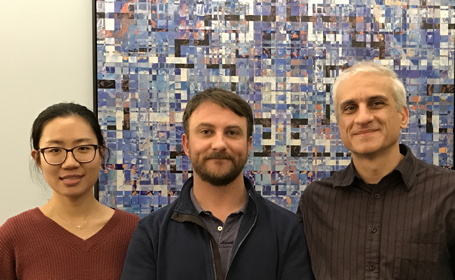
Speakers: Alexander Petrov, Declan Smithies, & Ying Yu:
Affiliation: Ohio State University, Psychology and Philosophy
Schedule: 10:45 am - 12:00 pm on Friday (2/15)
Session chair: Julie Golomb (Ohio State University, Psychology)
OnNeuro video: http://www.youtube.com/watch?v=7kb8CAMc9eE
Abstract:
This paper presents a new puzzle about the visual appearance of space. We review experimental data -- including classic data and new data from our own vision lab -- showing that visual appearance of shape is systematically distorted in ways that increase with viewing distance. Given these distortions, a square coffee table appears wider than it is deep. As you walk around the table, its appearance changes. And yet the table does not appear to change in shape. On the contrary, it appears perfectly rigid! But how can something appear to have the same shape when its apparent shape is changing? Having presented this puzzle, we take some preliminary steps towards solving it.
See photos of the talk or
go back to the Workshop main page.
Susanna Schellenberg
Constancy, Variance, and Situation-Dependent Properties
Speaker: Susanna Schellenberg
Affiliation: Rutgers University, Philosophy
Schedule: 9:15 - 10:30 am on Friday (2/15)
Session chair: Todd Ganson (Oberlin College, Philosophy)
Abstract:
This paper develops a framework in which to discuss the variant and invariant aspects of perception. In light of this framework, I argue that perspectival properties are best understood as situation-dependent properties: external, mind-independent properties that are constituted by intrinsic properties and situational features, where situational features include the perceiver's location, lighting conditions, acoustic conditions and other mind-independent features that affect the way an object is presented. I defend the situation-dependent properties approach against objections.
See photos of the talk or
go back to the Workshop main page.
James Todd
Is there a consistent geometry of visual space? And, why should judgments of 3D structure be systematically distorted?
Speaker: James Todd
Affiliation: Ohio State University, Psychology
Schedule: 9:15 - 10:30 am on Saturday (2/16)
Session chair: William Warren (Brown University, Cognitive Science)
OnNeuro video: http://www.youtube.com/watch?v=LStrMTUvsYs
Abstract:
This talk will consider two different ways of conceptualizing the geometry of visual space. The extrinsic geometry of visual space examines the specific properties of the physical environment that remain invariant over the mapping between physical and perceived space. The intrinsic geometry of visual space, in contrast, examines the formal relations among an observer's spatial judgments, without considering any corresponding measures of the physical environment. I will review several classic findings from the literature on this topic, which demonstrate conclusively that the extrinsic geometry of visual space for large open fields is neither projective, affine nor Euclidean, and that the intrinsic geometry of visual space does not have a homogeneous distance metric. The reason why perceptual judgments can be systematically distorted is that they are based on available sensory information that can only uniquely specify certain aspects of environmental structure, whereas other aspects are inherently ambiguous. As a result of this ambiguity (especially with respect to metric structure), the pattern of errors in observers' judgments can vary with the types of sensory information that are available (e.g., texture, shading, motion or binocular disparity) and the particular strategies that observers adopt for performing a required task.
See photos of the talk or
go back to the Workshop main page.
Mark Wagner
Putting the Geometries of Visual Space into Perspective
Speaker: Mark Wagner
Affiliation: Wagner College, Psychology
Schedule: 4:30 - 5:45 pm on Saturday (2/16)
Session chair: Wayne Wu (Carnegie Mellon University, CNBC)
OnNeuro video: http://www.youtube.com/watch?v=4HFdI9eonPw
Abstract:
Varying measures and experimental conditions can lead to different conclusions about the structure of visual space. This talk examines some of my past work that approaches this problem from multiple perspectives. I discuss two meta-analytic reviews of past research from both the direct estimation and size-constancy literatures. In both cases, judgments are affected by instructions, stimulus orientation, cue conditions, age, and other factors. The transformation model of size judgment is used to describe these results. Two of my early studies showing that visual space is compressed in the in-depth dimension relative to the frontal dimension are then reported. A recent meta-analysis and an associated empirical study show this compression increases with distance from the observer. Finally, a recent study in association with Hatfield suggests that visual space does not reflect a simple Affine transformation of physical space but must include elements of perspective.
See photos of the talk or go back to the Workshop main page.
